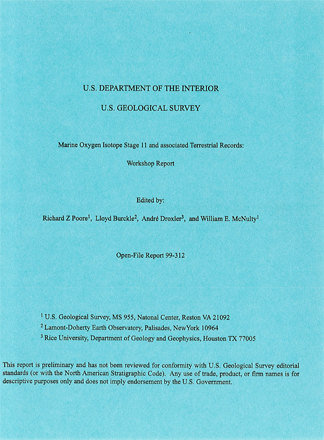Marine Isotope Stage 11
December 5, 1998 – San Francisco, California
Convener: Richard Poore

Summary
Because of the concern for potential global climate change, there is growing interest in better understanding and documentation of the history of natural climate and environmental changes. Information on recent periods of the Quaternary when conditions were demonstrably warmer than the present provides a way to gain insights into the likely impacts of possible future warming and represents one means for identifying any human-induced diversions from natural variability. Key features include the amplitude and periodicity of decadal to millennial-scale climate variability, the identification of systems and areas that are most impacted by warming, and the links between the carbon cycle and global temperature. The potential impact of increasing global temperature on ice caps and sea level is especially critical. Many glaciers and small ice caps around the world are receding rapidly. If larger ice sheets begin to recede, sea level could change dramatically. The most vulnerable ice sheet in the marine-based West Antarctic Ice Sheet, which contains enough water locked up as ice to raise sea level ~5-6 meters.
An increasing number of studies point to marine oxygen isotope stage 11 (MIS 11) (423-362 ka) as the longest and warmest interglacial of the past 500 kyr (see Howard, 1997 for summary). Modern barrier reef systems may have originated during or shortly before MIS 11, and sea level may have been substantially higher than present during MIS 11, implying collapse of one or more major ices sheets, like the West Antarctic or Greenland Ice Sheets, or both. Milankovitch forcing due to changes in Earth’s orbital parameters during MIS 11 was similar to modern conditions, as were millennial-scale climate variations. Thus, MIS 11 is a prime candidate for an interglacial that can provide a credible scenario for a future global warming.
In order to better define research objectives and sampling needs for future work on MIS 11, a one day international workshop with over 25 participants was held. Five summary presentations, followed by a poster session and informal presentations, generated lively discussions and focused on the issues: (1) How was MIS 11 generated and how long did it last? (2) Was the Earth warmer and sea level higher than present during MIS 11?
Workshop Report (pdf)
Organizing Committee
Richard Poore, U.S. Geological Survey
Lloyd Burckle, Lamont-Doherty Earth Observatory
Andre Droxler, Rice University
William McNulty, U.S. Geological Survey






